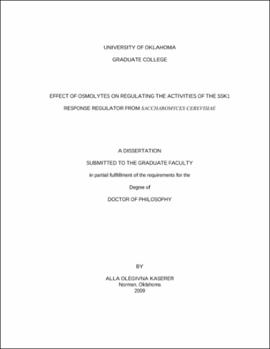| dc.contributor.advisor | West, Ann H | |
| dc.creator | Kaserer, Alla Olegivna | |
| dc.date.accessioned | 2019-04-27T21:34:15Z | |
| dc.date.available | 2019-04-27T21:34:15Z | |
| dc.date.issued | 2009 | |
| dc.identifier | 99309345002042 | |
| dc.identifier.uri | https://hdl.handle.net/11244/319044 | |
| dc.description.abstract | The multi-step His-Asp phosphorelay system in Saccharomyces cerevisiae allows cells to adapt to osmotic, oxidative and other environmental stresses. The pathway consists of a hybrid histidine kinase SLN1, a histidine-containing phosphotransfer (HPt) protein YPD1 and two response regulator proteins, SSK1 and SKN7. Under non-osmotic stress conditions, the SLN1 sensor kinase is active and phosphoryl groups are shuttled through YPD1 to SSK1, therefore maintaining the response regulator protein in a constitutively phosphorylated state. The cellular response to hyperosmotic stress involves rapid efflux of water and changes in intracellular ion and osmolyte concentration. To address the effect of osmolytes on the regulation of this signaling pathway, the individual and combined effects of NaCl and glycerol on phosphotransfer rates within the SLN1-YPD1-SSK1 phosphorelay were examined. In addition, the effect of osmolyte concentration on the half-life of the phosphorylated SSK1 receiver domain in the presence/absence of YPD1 was evaluated. The results show that the combined effects of glycerol and NaCl on the phosphotransfer reaction rates are different from the individual effects of glycerol and NaCl. The combinatory effect is likely more representative of the in vivo changes that occur during hyperosmotic stress. The results revealed that increasing osmolyte concentrations negatively affects the YPD1*SSK1~P interaction thereby facilitating dephosphorylation of SSK1 and activating the HOG1 MAP kinase cascade. At high osmolyte concentrations, the kinetics of the phosphorelay favors production of SSK1~P and inhibition of the HOG1 pathway. | |
| dc.description.abstract | A similar multi-step signaling pathway is also utilized by Candida albicans, which is known for adaptation to oxidative stress, morphogenesis, cell wall biosynthesis and virulence in this opportunistic pathogenic yeast. To biochemically characterize major components of this pathway, studies were focused on in vitro reconstitution of the multi-step phosphorelay from C. albicans and biochemical characterization of the CaYPD1 (HPt protein) and CaSSK1 (response regulator protein). The heterologous phosphoryl transfer system SLN1-HK-RR → CaYPD1→ CaSSK1 (or SSK1) was established and examined. The CaYPD1 histidine phosphotransfer protein exhibited similar phosphotransfer specificity in vitro towards the response regulator domain of CaSSK1-RR and SSK1-RR. The half-life of the phosphorylated regulatory domain of CaSSK1-RR was also measured and was approximately 9 min with a corresponding rate constant of 0.078 min-1. This result demonstrates a similar rate of CaSSK1-RR dephosphorylation compared to SSK1-RR suggesting possible functional similarities between these two response regulator proteins. | |
| dc.description.abstract | Mutational analysis of the CaSSK1 response regulator domain was also performed. Mutants were expressed, purified and their activity was analyzed using an in vitro phosphorylation assay. Little or no phosphorylation was observed for the CaSSK1-RR D556N mutant. The radiolabel primarily resided with the CaYPD1 protein and did not get transferred to the D556N mutant. Likewise, the D513K mutant was also severely impaired in its ability to be phosphorylated by CaYPD1. The receiver domains of the D556N and the D513K mutants could not be appreciably phosphorylated in vitro indicating that constitutive activation of HOG1 occurs in vivo due to the inability of CaSSK1 to be phosphorylated. | |
| dc.format.extent | 166 pages | |
| dc.format.medium | application.pdf | |
| dc.language | en_US | |
| dc.relation.requires | Adobe Acrobat Reader | |
| dc.subject | Saccharomyces cerevisiae | |
| dc.subject | Phosphotransferases | |
| dc.subject | Cellular signal transduction | |
| dc.subject | Protein kinases | |
| dc.title | Effect of osmolytes on regulating the activities of the SSK1 response regulator from Saccharomyces cerevisiae | |
| dc.type | text | |
| dc.type | document | |
| dc.thesis.degree | Ph.D. | |
| ou.group | College of Arts and Sciences::Department of Chemistry and Biochemistry | |
